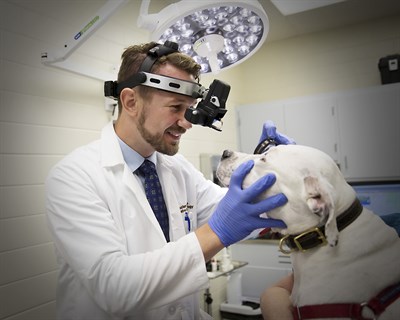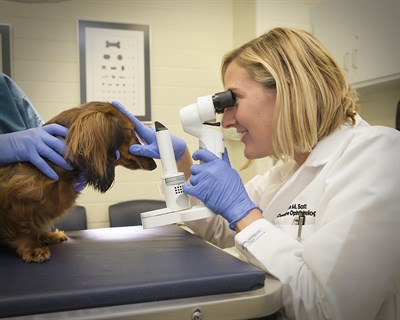All Eyes on Ophthalmology
For many animals and pet owners, the latest specialty service at the College of Veterinary Medicine & Biomedical Sciences (CVM) is considered the site for sore eyes. After five years of absence, the Ophthalmology Service has returned to the Texas A&M CVM and has brought along with it Dr. Erin Scott and Dr. Lucien Vallone, both clinical assistant professors in the Department of Small Animal Clinical Sciences.
The Texas A&M Ophthalmology Service officially began “seeing” patients on January 11, 2016, and is expected to see approximately 1,300 cases in its first year of operation. Scott and Vallone, two New York natives, began working at Texas A&M; University in the summer of 2015, extending their best efforts to get the service up and running. Today, they are prepared for anything that walks through the door-from penguins to dogs to horses and cattle.
Generally, the Texas A&M Ophthalmology Service works on referrals from primary care veterinarians, but the service is also an important resource to rural communities in the Bryan/College Station area that may not otherwise have access to an ophthalmologist.
“The family veterinarian is a wonderful front line for detecting eye diseases. If they see any abnormalities, then they can send a referral to us,” Scott said. “We are here to chat with clients one on one, educate them about their pet’s eye disease, and develop the type of relationship that I think they appreciate.”
Experts in Eyes of All Types

Both Scott and Vallone are diplomates of the American College of Veterinary Ophthalmologists (ACVO), meaning they are the best of the best. Only about 400 veterinarians have completed the additional four or more years of schooling after veterinary school required to specialize in veterinary ophthalmology. This training gives them expertise in a wide range of procedures and the ability to treat an assortment of species, from livestock to pets to wildlife.
“We’re trained to know about the differences in many species ranging from fish to non-human primates,” Scott said. “For the most part, the eye works the same in most species and has very similar structures, but there are intricate differences between each species that we need to be aware of.”
Notably, the service has recently collaborated with Moody Gardens in Galveston, Texas, to provide care to penguins with age-related cataracts. “That was a really fun experience set up by our Zoological Medicine Service to respond to a request from Moody Gardens, which is an aquarium and interactive park open to the public. They happened to have about 30 penguins affected by some level of lens disease,” said Vallone. “Moody Gardens is interested in making their animals as comfortable in their environment as possible by getting ophthalmologists to screen them for cataracts and potentially treat them. So far, we’ve successfully treated three penguins with blinding cataracts.”
The Importance of Veterinary Eye Care

Unlike most humans, many animals rely on senses other than vision and can adjust well to loss of sight. “Vision, for dogs, is not their most important sense,” Scott said. “Even if they are permanently blind, they still have a wonderful quality of life. We can give their owners different options, and the options that may not be standard for humans can be very good for our patients. We focus on educating owners about how to protect their blind pets from certain dangers.”
“We often transition the conversation to comfort rather than vision because most dogs will adapt perfectly even without their vision,” Vallone echoed. “Some owners don’t even know that they have a blind dog because the dog has memorized the layout of the household. When the owners take them to an unfamiliar environment, they may notice that their dog has bumped into a few things.”
Although many animals can adjust to vision loss, it is no less important to maintain good eye health. Some eye conditions can cause pain or discomfort and should be treated. “The most common condition would be glaucoma, where there’s a high painful pressure inside the eye that’s damaging the tissues and causing blindness,” Scott said. “If we can’t control the pressures, there are salvage procedures that we can offer that can provide comfort, even if vision cannot be saved.”
Training the Next Generation of Veterinarians
In addition to their clinical duties, Scott and Vallone serve as professors and impart their knowledge to veterinary students. Like their colleagues at the CVM, Scott and Vallone use the latest and most effective teaching methods to keep students engaged and help them retain what they learn.
“We are currently teaching the third-year veterinary class,” Scott said. “They have a medicine mega-course in which they complete 10 hours of ophthalmology. We’ve completely revamped our lectures with the help of the Center for Educational Technologies, and we use Moodle, an online resource that allows us to ask questions and allows the students to answer on their laptops in the classroom. We can get real-time answers and be able to discuss any gaps in their knowledge. We’ve been getting positive feedback so far regarding our lectures.”
Renovations to the CVM’s facilities also pave the way for positive changes in the classroom. “The sky is the limit for how interactive you can make the program,” Vallone said. “The new Veterinary & Biomedical Education Complex will be much more accommodating to interactive learning. There, we can break up the classroom structure and create seating arrangements that accommodate smaller groups versus just a block of a hundred students, which makes it difficult to walk around and answer individual questions.”
For some students, the rotation with the Texas A&M Ophthalmology Service inspires them to pursue a specialty. Even if the students don’t specialize in ophthalmology, their training with the Ophthalmology Service allows them to understand what is normal and abnormal and when they should refer a patient to a specialist. “I’ve seen where students come in through a sense of obligation because they feel like it’s a requirement to be able to understand how to do an eye exam, but then they leave with a new found interest for the actual subject,” Vallone said.
Similarly, Scott said, “I know the students really felt a need for more in their training in ophthalmology, so it was so easy to get them to come to our rotation, and they’re really eager to learn and really appreciative of everything that we offer. I’ve had just wonderful interactions with the students.”
Vision of the Future
Although the service has just opened, Scott and Vallone already have plans to expand, something they’ve been doing since day one. “We had to renovate the space that was definitely not suited to seeing more than one case at a time, and now we’ve converted it to two exam rooms and a small work area so that we can accommodate students and try and expand our case load,” Vallone said.
With the addition of a newly renovated small animal hospital, Scott and Vallone foresee their workspace potentially doubling in size to better accommodate patients and students alike. “We joke that we make use of every single inch of our space,” Scott said. “Certainly, in the future, it will be great to have more space.”
The Texas A&M Ophthalmology Service’s plans also include expanding research. “We have a study that will be starting soon,” Scott said. “We’re looking at pain management in dogs that have their eyes removed for ocular disease, and we’ll be collaborating with the Anesthesiology Service for that study. I know Dr. Vallone is working on identifying a new structure in the horse third eyelid that has never been described before. We have many different projects in the mix. Right now they’re all in their infancy, but in the next year or so they’ll really start to take root and build. I would say for the most part our research is clinical, so we are bridging what we do in the clinics to different avenues of research.”
Interdepartmental collaboration is also a priority for the Ophthalmology Service. Scott said, “Another collaboration that we have is with the Zoological Medicine Service. It’s interesting-they see so many different exotic species that really haven’t had their eyes described. Particularly, we’ll be looking at quail and studying their ocular parameters.”
But what makes the Ophthalmology Service strong is teamwork. Scott and Vallone rely on each other for support and guidance. “It’s great that Texas A&M; considered hiring two people at the same time,” Vallone said. “Starting a service that hadn’t been here for five years can be challenging. I wouldn’t have been able to do it alone.”
Dr. Erin Scott
Clinical Assistant Professor Dr. Erin Scott of the Department of Small Animal Clinical Sciences (VSCS) found her way to Texas A&M; University in 2015 as she pursued a career as an academic. Scott graduated from the veterinary college at the University of Pennsylvania, completed an internship at Louisiana State University and a fellowship and residency at the University of Wisconsin-Madison.
Dr. Lucien Vallone
Veterinary medicine wasn’t the first career choice for Vallone, now a clinical assistant professor with VSCS. Vallone started out as an engineering major at Binghamton University in New York, and he eventually applied to veterinary school and was accepted to Mississippi State University and later completed an internship and residency at Cornell University.


